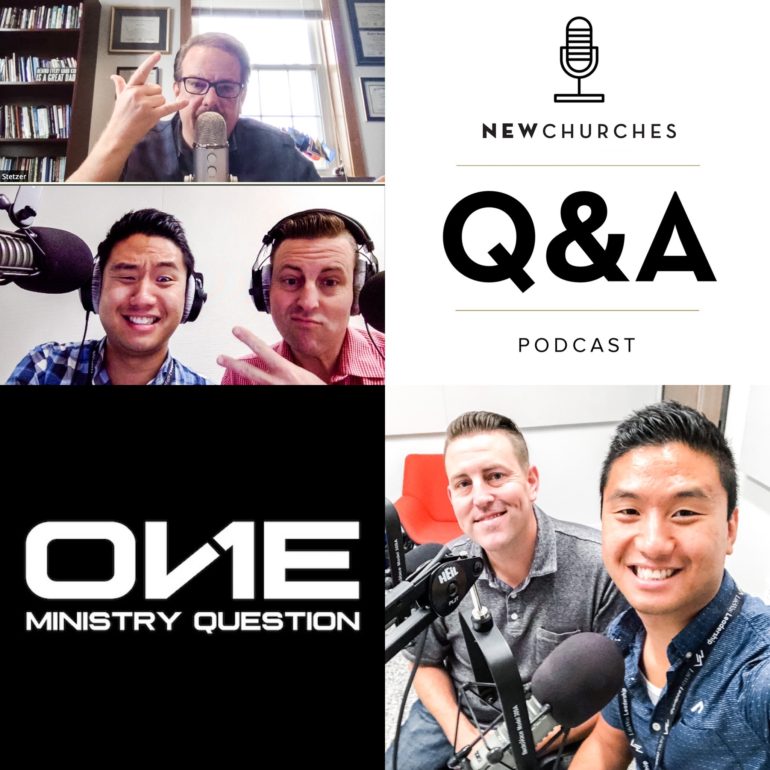
A few years ago, Ed Stetzer and I co-wrote a resource to catalyze movemental church planting. It’s called “1,000 Churches: How Past Movements Did It—And How Your Church Can, Too.” This is the final chapter.
In order to experience a movement of multiplication and plant 1,000 churches in your lifetime, you need to multiply everything: disciples, leaders, groups, ministries, and churches. Multiplication needs to literally become the core value for your church. It has to be so core that it becomes viral—spreading, infecting, and reproducing everywhere.
From the foundation of a church, success needs to be redefined from addition to multiplication. It requires a fundamental shift of metrics and celebration in the culture of your church. Part of how you do that is by carefully evaluating what you celebrate, what you mourn, and the stories you tell. When those three things in the life of your church tie back to multiplication from the beginning, it will help develop both a tangible culture (in what is measured) and an intangible culture (in what is felt) to drive toward a new way of approaching success.
There are steps we can take now to help increase our church planting passion and capacity. They will help us get there but only as part of a broader movemental focus. For example, churches and denominations can and must:
1. Welcome the Planter
Let’s be transparent. If you are a church planter, just look at yourself in the mirror. You can be a pain at times. You are a maverick and a self-starter, an entrepreneur. You can also be hard to work with. That drive is part of what makes you successful, and that same drive can kill or stagnate your church if left unchecked or unfocused. You had a vision of the way church should be when you planted, and it was obviously “better” than others you experienced. This is the God-given dissatisfaction that leads visionaries to plant churches.
The first principle to move toward viral multiplication is to not be offended when church planters you raise up and send out feel the same about you. When others don’t want to work out of your playbook, it is easy to become offended or cut capable leaders off from the pipeline because of a perceived lack of alignment (for more information about pipeline, see point three below). In these moments, self-awareness and a kingdom mindset are vital to holding fast to multiplication.
Remember that you likely felt the same way when planting your church.
Instead, begin listening to the dreams that God has laid on the heart of capable leaders in your church. Default to openness, and seek to be a leader who equips others for gospel ministry. Part of an equipping leader mentality involves helping budding leaders harness their holy discontent and channel it toward kingdom ministry. Instead of criticizing pre-existing systems, listen to their ideas and celebrate their passion, but be open to critique. Help them redirect it from theory to practical next steps, disciple them toward personal maturity, and guide them toward a wise course of action.
If you want to plant rabbits, you need to learn how to let go and welcome the planter who wants to hunt for carrots in a different way than you have.
2. Start a Network
In order to create movemental energy where you can continually influence daughter, granddaughter, and great-granddaughter churches, starting a network is incredibly effective in aligning multiple churches onto a similar page. It cannot be about power or control; the motivation must be gospel partnership and a transferrable vision. The team must be stronger together than separate. After all, the only way you are going to get to 1,000 churches in your lifetime is if you take a rabbit approach, rather than an elephant one.
They say it takes a village to raise a child, and in the same way, it must take a network to raise a movement. As you think about a network, it’s important to remember principle number one: there is a fine balance between alignment with vision and theology versus an openness to a wide-variety of approaches and systems. If your network is too closed, it will never reach viability and be able to multiply because there will not be enough people able to fit into your model. However, if your network is too open, it will be so broad that major theological differences will cause more division among the team than alignment. It requires a fine balance, with much prayer and intention, but creating a network will give you the medium to be able to continually add coals onto and fan the flames of multiplication. More on this later.
Creating a network, for those wondering, does not mean you can’t be a part of a denomination. Actually, smart denominations are encouraging networks, as we explain in the book we co-authored, Planting Missional Churches. Take a look at the two largest evangelical denominations (neither of whom generally likes to be called a “denomination”), the Southern Baptists and the Assemblies of God. They have intra-denominational networks (The SEND Network in the Southern Baptists and The Church Multiplication Network in the Assemblies of God), both of which help church planting nationally and locally.
3. Implement a Leadership Pipeline.
Unless you have a way to develop leaders at every level of your church (volunteers, leaders, coaches, ministry directors, and senior leaders) you will never get to 1,000 churches, let alone reproduce your own church at least once. We’re not talking about leadership placement; we’re talking about leadership development and there’s a difference.
Leadership development versus leadership placement becomes an unseen force that, like driving while the emergency brake is activated, can greatly hinder a church from effective multiplication and movement. With placement, you take an already strong leader and place them in a position or role. And in budding church plants, where a planter is desperate for any help, this is often the easiest, simplest, and quickest way to fill in the gaps.
But it’s near impossible to change that culture as the church begins to grow. Recruitment focuses on the placement of the right leaders in the right positions, and prayer for qualified leaders becomes prominent in staff meetings. Those in the wings who are humble and teachable, yet inexperienced, are left without an opportunity. On the other hand, leadership development looks for the humble and teachable person who has the potential to grow into a leadership role. Metrics are less about experience and more about willingness. Prayer for qualified leaders is more about humble people over experienced professionals. This allows all God’s people, and especially those who are young and passionate for ministry experience, to have an opportunity for growth. Often the most qualified and passionate leaders in a culture of multiplication are the ones that have been raised up from within that culture. It becomes less about adopting someone else’s vision and more about being shaped within and in the vision of your church. When churches crack this development versus placement code, they release the parking brake, shift into first gear, and burn rubber on the multiplication highway.
Over a two-year process, LifeWay Leadership convened 18 leadership experts. These were leaders in the church and outside of it, from different backgrounds, perspectives, and positions. Through a series of meetings, we wrestled through the idea of leadership development and if there were a core set of competencies that leaders shared, regardless of position. As outlined in the book, Leadership Code, 60-70 percent of leadership is transferable from position to position. In other words, up to 70 percent of what makes a leader effective in one organization, role, or position, is transferable to another organization, role, or position. In the course of these meetings, we uncovered over 280 competencies that effective leaders shared. While studying and filtering through this data, we uncovered a pattern. There were six broad categories that stood out as common themes:
- Discipleship: Theological and spiritual development
- Vision: Preferred future
- Strategy: Plan or method for the preferred future
- Collaboration: Ability to work with others
- People Development: Contributing to the growth of others
- Stewardship: Overseeing resources within one’s care
These are the six core competencies for any and every leader within your church. Of course there are ministry-specific competencies, like rhythm for a musician or the ability to ask questions for small group leaders. However, regardless of the ministry area that leaders serve in, these six shared core competencies will guide their growth and development.
So, have you implemented a leadership pipeline in your church that develops new leaders and doesn’t simply train those already qualified?
4. Start a Residency Program
This is the bread and butter of a larger reproducing church. A residency program is the pathway to raise up and release your first church planter. Unless your church is churning out church planters left, right, and center, how do you expect to catalyze others to do the same? Training church planters involves more than just training on how to send out a mailer. This must be a sustainable, reproducible, and simple residency that trains in spiritual maturity, practical ministry competencies, and theological knowledge. Church planters need to be generalists, and a residency that is robust enough to give potential planters experience in every area of ministry benefits the church and the planter. You need to model being a church planting church so that all of your daughter churches will do the same, and their daughter churches, and their daughter churches. Through this residency program you will assess, train, fund, and coach your future army of church planters. And if a planter has been raised up within your system and has personally benefited from it, they will become the chief evangelist and the strongest advocate for doing it in their church. Whatever impacts us the most is what we will champion, celebrate, and share.
5. Plant by Multiplication, Not Primarily by Funding, but Care About Funding
You can’t buy your way into a church multiplication movement. If 1,000 churches were for sale, you can bet there would be a firestorm of people vying to buy! You can’t get into this scale of reproduction with money alone. It’s important to remember that money is definitely a factor. After all, networks like Acts 29 and ARC have large churches with big budgets that have funded their operations. So, if you’re going to create and facilitate a national or even a global network to plant 1,000 churches, then you’ll need to put a disproportioned amount of funding in. But, the key factor is having multiplying churches that will support churches, because you will never have enough. There are typically two ways to do this.
Pay It Back: When you send out a church planter with money, you can ask them to give a percentage back into the network’s church planting fund, in order to resource future church plants. We prefer that you ask planters to give back in perpetuity so that they feel like they’re a part of the team, stay connected to the network, and are continuing to resource other church plants, instead of simply paying back a loan.
Pay It Forward: You can also tell planters to pay it forward. In other words, when you give them money, you can ask them to commit to continually giving a percentage of their budget into church planting. This would be something that the leadership of their church would direct and lead, rather than a centrally controlled fund by the network or the mother church.
This keeps churches relationally connected with their church plants and deeply vested in their success. Where the money goes, that’s where the heart goes, too. Churches that directly fund other churches develop a heart connection.
Funding is a sacrifice, especially for a church plant. But the benefit of funding new churches as a budding church is the DNA that it instills. Remember, whatever is measured is accomplished, and whatever narrative is celebrated or mourned shapes the culture. So the sacrifice of money will reap far greater-reaching rewards in shaping a multiplication culture.
6. Be Born Pregnant
Imagine if every church plant you sent out was born pregnant? What if, in every church planting prospectus, church planters outlined their plan for planting their first daughter church? This can be a plan for recruitment, filling the residency in the formation stage, or setting aside resources to draw planters in. The most important factor in this idea is simply having a plan. For example, on the very first Sunday at Grace Church—the church I (Ed) most recently planted—we announced that 100 percent of our very first offering was going to go to our daughter church plant. This is what essentially shaped our DNA from the beginning. And when we planted, that’s what we did. Subsequently, we’ve sent out two of our leaders and elders to plant churches—one in Nashville and one internationally. The seeds at the beginning of a church and a movement determine so much of the outcome.
7. Open More Lanes
In addition to developing a traditional path to assess, train, fund, and coach church planters (your residency program), you need to open other lanes in order to plant 1,000 churches in your lifetime. For example, what’s the path to plant for bi-vocational planters? Your training needs to be adaptable enough for the 20-something-year-old barista steaming drinks for rent money, as well as the 65-year-old retired individual who has his financial freedom, but has received a call from God to plant. It needs to be layered so that a bi-vocational family-man can be trained in the same system as a full-time, newly married resident. Maybe it would take longer, but a graduated, inclusive program will train a wider array of people. What about planting a church among immigrants? Or what about planting house churches outside the edge of town? The training must work in multiple cultures, socioeconomic categories, and geographic locations. In other words, don’t make the mistake of only funding and training one type of church planter. Your default tendency will be to reproduce yourself and your unique style of ministry. This is who will initially be attracted to you. But realize that reproducing yourself alone will not lead you to planting 1,000 churches.
What If Everyone Leaves?
People in your church are going to be nervous. They’re going to say, “Now, wait a second. If we send people out, won’t our church decline?” Statistically, the most likely scenario is that it won’t. Jeff Farmer (researcher and professor at New Orleans Baptist Theological Seminary) did a comparison study of 75 churches and found that churches who planted, when controlling for other factors of similar size and passion, actually grew. When you send people out to plant, others will show up and step into leadership roles.
When I (Ed) planted a church in Erie, Pennsylvania, we decided to start two daughter churches. We said we were going to have twins, so we planted two daughter churches on one day with residents. For six months, these residents were on staff where they walked with us and we trained them. We then gave them a three-month transition period where they had a fishing license to anybody in our church. We blessed and encouraged them to approach anyone in the church with a challenge to come and plant with them. At that point, we were running 350–400 in attendance, so when they got about 50–75 people to go with them, it hurt. It was a lot more than we expected.
One whole worship team and a drummer—we had two worship teams—got a vision for church planting and decided to leave. This meant we now had no drummers in our church when they would leave. We said to our church during one of the preview services, “Listen. We’re so excited about what’s happened and how you have rallied around these church plants we’re sending out. But did you notice there’s no drummer today? We had to use a track.”
After the service, one of the members came up to me and said, “You know, I could be the drummer.”
And I said, “That’s awesome, man. But have you ever been a drummer before?”
He said, “Yeah, yeah. I used to tour professionally as a drummer.”
“What?” I was shocked because our previous drummer struggled. I mean we had a drummer all these years and he was painfully bad, but at least we had a drummer. And now this guy, who was a professional drummer, who had played for a couple different famous bands, comes up to me
and tells me this?
“Are you serious?” I asked him, “Why have you never said anything?”
“Well, you know, I just wanted the guy to have a shot who was up there.”
“Dude, you’re killing me.”
This is what happened throughout the church. After we sent out people, others began stepping up to the challenge and taking on leadership responsibilities. So, cast a vision for this and allow God to send people to fill the void!
Start a Network of Networks
One of the seven principles of multiplication is to start a network. In order to plant 1,000 churches in your lifetime, this is a must. However, our purpose in this book is not to discuss the nuts and bolts of starting a singular network but to share the need to start a network of networks. This takes the principle of multiplication up from leaders, groups, and churches and into how we think about organizing mass groupings of churches.
Take the NewThing Network for example. They are not simply one of the fasting growing networks out there, but they are a network of networks that have undergone tremendous growth by thinking in terms of multiplication rather than addition. In 2016, they grew from 267 to 1,176 churches in one year. They were able to do this because in that same year, they went from 29 to 50 networks within their larger NewThing Network. While NewThing still maintains a distinct DNA, they have released leadership and multiplied themselves so that each local network is finding, planting, and training planters they know and can be accountable for. NewThing then resources each network around their common vision, values, and strategy.
This network multiplication strategy allows you to open up new lanes to planting, since you’re going to have some networks within yours that are better at training bi-vocational planters, others focused on rural areas, and still others focused on highly dense urban centers. This strategy also gives you the opportunity to think and plant globally. Now before you go and fly to Ulaanbaatar in Outer Mongolia and start planting churches, remember that you need indigenous partners. This is one of the characteristics of a movement!
Since NewThing was able to find indigenous partners in Africa, India, and around the world, they’ve seen explosive growth in their network this past year. However, NewThing didn’t just partner with whoever had a pulse. They made sure that their partners shared the same values and DNA. They then did trips both ways—the NewThing leaders going over to those countries and those indigenous leaders coming over to the United States. After all, the further you are—culturally and socioeconomically—the harder it is going to be to stay on the same page.
Three-Self Churches
When you plant globally, both through indigenous partners and by going to Unengaged Unreached People Groups (UUPG), you need a sound missiological strategy that produces three-self churches. In this last century, two missiologists, Henry Venn and Rufus Anderson, discovered that when churches thrived long-term on the mission field, they always shared these three-self values: self-governing, self- propagating, and self-supporting.
In a global network, it is vital to ensure that the churches you start always have a plan in place to become self-governing, self-propagating, and self-supporting. Raising up a team of godly leaders to self-govern the church gets it to the place where it is its own church. This is also where a leadership pipeline gets its first provable experience—in raising up a governance body regardless of your specific ecclesiology.
Self-propagating is another key factor in planting globally and should be here as well. In a multiplying culture, churches need to be seeded with the right DNA that motivates them to be a part of planting other churches.
Finally, self-supporting churches are another value that needs to be consistently championed and expressed. Church plants can’t be continuously supported or else you cannot support the next church plant. Most new churches are not going to start that way. However, you need to have a plan to move them toward this, or you will get into a partnership that will feel like a never-ending black hole and it will ultimately prevent you from planting 1,000 churches in your lifetime. Supporting dormant and dependent churches will hinder the vision and keep you from the ultimate goal, so it’s important to clearly define church partnerships with expiration dates for funding, and clear measurable goals for planting churches and raising up leaders. It’s helpful to set up defined partnerships with expiry dates and clear faith outcomes that are relationally driven with quantifiable outcomes that meet the expectation of donor and dependent ministry.
A 20-Year Focus
No one in recent history has been able to get to 1,000 churches unless they stayed focused on it for at least 20 years. One hundred years ago, we got there in 10-15 years. But nobody in our lifetime has seen it without a sustained 20-year focus.
When John Wimber with the Vineyard focused on church planting, they experienced astronomic growth. Yet as their focus drifted to other issues, that’s when the momentum began to wane (though they are refocused again today). Most of the Calvary Chapels were planted within the first 20 years of that movement, and now the movement is in transition after Chuck Smith’s death. Now Hope Chapel has been able to extend a little longer as well. But when looking at recent history, it seems to us that you have to pull this direction for at least 20 years.
So, what story are you going to write? What are the next 20 years going to be like for you? Will you start down this road so that you can be a part of a movement that plants 1,000 churches in your lifetime?
We are ready to not just rejoice at movemental Christianity around the world—we want it here. And, we believe it can happen. Yes, it will require change and sacrifice, but what worthwhile thing does not? So, join us. Let’s provoke one another to “love and good works” (Hebrews 10:24) and toward exponential church planting in the form of Church Multiplication Movements.
As you look at your plans, don’t just go to one place—we are at “the end of the earth” now (Acts 1:8). You need to think that way. Recently, I sat down with a church like an investor would with a client, and I encouraged them to have a balanced portfolio. Some of it is hard but can pay great rewards, like an unengaged and unreached people group. Other parts will be easier, but with more than one approach, the 1,000 churches you see planted in a lifetime will change a whole lot of other lives.
As such, we leave you with an investment roadmap for church planting. You won’t be able to do it alone, and you will need partners, networks, denominations, and other mission agencies, but it’s the kind of investment that changes everything.
Practical Path to 1,000 Churches
To get your strategic planning and creative juices flowing, consider this practical roadmap to help you plant 1,000 churches in your lifetime.
1. LOCAL MOVEMENT: 10 CHURCHES
- Plant locally
- Develop your leadership pipeline
- Create a residency program
- Start a network
2. REGIONAL MOVEMENT: 100 CHURCHES
- Identify future network leaders among your residents and equip them to start their own network within your network
- Plant through new lanes
- Have each network host a quarterly gathering where network churches come together for encouragement and training
3. NATIONAL MOVEMENT: 600 CHURCHES
- Gather your network leaders and help them start their own residency programs within their networks
- Keep the movement focused for twenty-years
- Host an annual gathering for everyone in all of your networks for vision and training
4. GLOBAL MOVEMENT VIA INDIGENOUS PARTNERSHIPS: 260 CHURCHES
- Have indigenous partners
- Reproduce three-self churches via missiologically sound principles
5. GLOBAL MOVEMENT VIA UNENGAGED UNREACHED PEOPLE GROUPS: 30 CHURCHES
- Have indigenous partners
- Reproduce three-self churches via missiologically sound principles
You can download this entire resource as a PDF here 1,000 Churches: How Past Movements Did It—And How Your Church Can, Too.”




